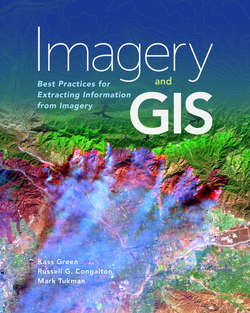Читать книгу Imagery and GIS - Kass Green - Страница 26
На сайте Литреса книга снята с продажи.
Imagery Workflows
ОглавлениеIncorporating imagery in a GIS requires first deciding how you want to use the imagery. Is it as a base image, as an attribute of a feature, or to make a map? If your goal is to make a map, you must relate the objects on the imagery to features on the ground. To do so, four steps must be completed. You must
1 1.understand and characterize the variation on the ground that you want to map,
2 2.control variation in the imagery not related to the variation on the ground,
3 3.link variation in the imagery to variation on the ground, and
4 4.capture the variation in the imagery and other data sets as your map information.
First, you must decide how you want to characterize the phenomena on the earth that you want to identify, analyze, and display on the map; i.e., you need to understand the variation on the ground that you want to capture on the map. Once you understand the variation on the ground, you will need to create a set of rules that classify the variation on the ground into meaningful categories for your proposed uses of the map. It is the map categories and proposed uses that will drive your choice of what type of imagery to acquire for your project. Knowing how to best make that choice is the objective of chapters 3 and 4. Knowing how to build a rigorous classification scheme is the objective of chapter 7.
Next, you must work with your imagery in your GIS, register it to the ground, and remove or manage any spurious variation in the imagery caused by clouds, cloud shadows, or atmospheric conditions that could likely lead to map errors; i.e., you need to control unwanted variation in the imagery. Chapter 5 reviews working with imagery in ArcGIS, and chapter 6 discusses registering imagery to the ground and dealing with unwanted image variation.
Third, you must understand the variation in the imagery and how it relates to the variation you want to map; i.e., you must link variation in the imagery to variation on the ground. To do so, you will inspect the imagery to understand how the image object elements of color/tone, shape, size, pattern, shadow, texture, location, context, height, and date vary across the landscape. There are analytics you can perform on the imagery to discover how well the imagery varies with the classes you want to map, and you may decide to manipulate the imagery data to produce indices or derivative bands that help derive more information from the imagery. You may discover that some of the variation on the ground that you want to map cannot be derived from the imagery. In that case, you must discover other data sources (i.e., ancillary data), such as DEMs, that will help you make the map. Creating DEMs and their derivatives is the topic of chapter 8. Understanding how to link variation in the imagery to variation on the ground is the learning objective of chapter 9.
Fourth, you will classify the imagery to create maps of digital elevation, feature locations, or thematic landscape classes by capturing the variation in the imagery and ancillary data that is related to your map classes. This work may be performed manually or with the help of a computer. There are many methods of classifying imagery. Explaining those methods and describing how to choose which method to use are the objectives of chapters 10 and 11. Once the image is classified into a map, you will want to assess the map’s accuracy, which is the topic of chapter 12. Finally, you may want to publish your imagery and maps, which is the topic of chapter 13.
